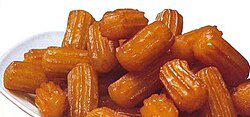Tulumba
 | |
| Type | Dessert |
|---|---|
| Place of origin | Ottoman Empire |
| Region or state | Countries of the former Ottoman Empire, Balkans, Middle East, Caucasus |
| Main ingredients | Flour, butter, salt, water, egg, syrup |
Tulumba (Turkish: tulumba tatlısı, Greek: τουλούμπα, Cypriot Turkish bombacık; Cypriot Greek πόμπα (pomba); Armenian: պոմպ (pomp) or թուլումբա (tulumba), Albanian tullumba, Bosnian tulumba, Bulgarian and Serbian: тулумба) is a popular dessert found in the cuisines of the former Ottoman Empire. It is a fried batter soaked in syrup, similar to jalebis and churros.
The sweet is also found in Iranian cuisine as bamiyeh, and in Egypt, as balah ash-sham (Arabic: بلح الشام). In the Arab world, it is called asabe Zainab (Zainab's fingers), and it is customarily consumed during Ramadan.

It is made from unleavened dough lump (about 10 cm long) given a small ovoid shape with ridges along it using an 'icing' bag with a special nozzle. It is first deep-fried to golden colour and then sugar-sweet syrup poured over it when still hot. It is eaten cold.
Name
Tulumba literally means 'pump' in Turkish, as does the Cypriot πόμπα.

